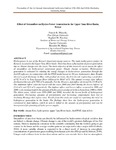Effect of Streamflow on Hydro-Power Generation in the Upper Tana River Basin, Kenya

View/
Date
2018-04Author
Musyoka, Francis K.
Wambua, Raphael M.
Mutua, Benedict M.
Metadata
Show full item recordAbstract
Hydro-power is one of the Kenya’s important energy sources. The main hydro-power project in
Kenya is located in the Upper Tana River basin. There has been a fluctuation of power generation
due to climate change over the years. The main objective of this research was to assess the effect
of streamflow on hydro-power generation under climate change scenarios. Hydro-power
generation is estimated by relating the runoff changes to hydro-power generation through the
ArcGIS software, in conjunction with ArcSWAT model based on 30-year hydrometric data. Results
showed a peak discharge in May, with gradual decrease, the first decade registering a peak flow
of 82.74 m3/s in Tana-Sagana River followed by 80.65 m3/s. The annual average dam inflows
declined at the rate of 0.7992 m3/s annually. For the 30 years, dam inflow decreased by 23.98 m3/s.
The minimum inflow rates increased with the years 2000 and 2009 having the lowest inflows of
21.4 m3/s and 22.8 m3/s respectively. The highest inflow and lowest inflow occurred in 1998 and
2009. A decreasing trend in the amount of hydro-power produced in the scheme from 1990 to 2010.
The driest years, which were 1999-2000 and 2009, recorded the lowest levels of hydro-power
generation. Decreasing amounts of precipitation and increasing temperatures have led to
declining Masinga dam inflow rates. Results from this study are useful in explaining the trend in
hydropower generation in the basin. The findings show how the hydro-power generation is
correlated to dam inflows, which in turn is linked to the amount of precipitation and can be
incorporated for planning of hydro-power supply.
Key words: stream flow, hydro-power, upper Tana River basin, ArcSWAT, dam inflow
